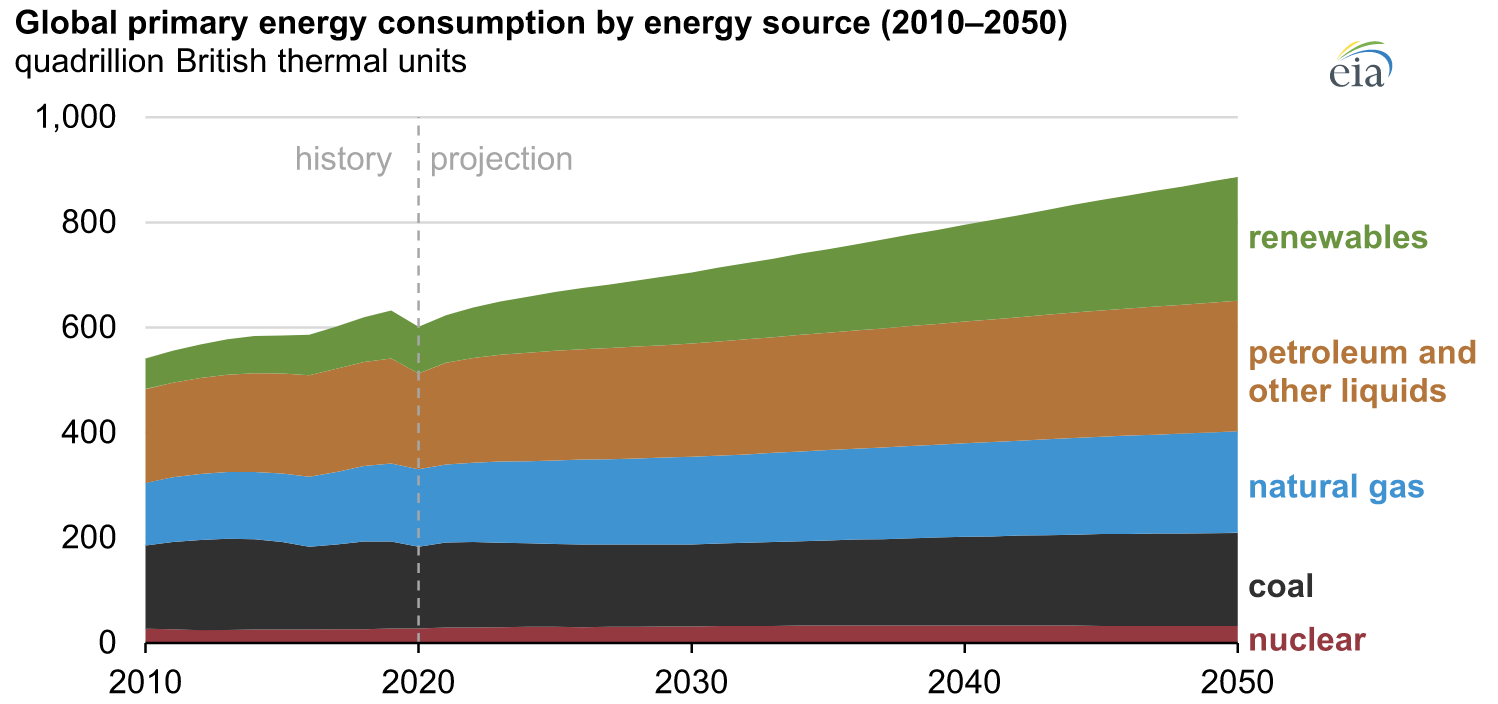The Energy Information Administration’s International Energy Outlook 2021 projects that global energy consumption and carbon dioxide emissions will increase nearly 50 by 2050 due to population and economic growth. EIA assumes in its reference case that current laws and regulation are in effect, i.e. the agency does not assume significant changes to policy or major technological breakthroughs. Regardless, the agency does see major increases in renewable energy worldwide, but does not see those renewables fully replacing fossil fuels in the next 30 years. According to EIA, oil and natural gas production continue to grow, mainly to support increasing energy consumption in developing Asian economies. In 2020, fossil fuels represented about 80 percent of primary energy consumption worldwide and by 2050, they still represent about 70 percent under EIA assumptions, but in a much larger market. Global carbon dioxide emissions increase by 25 percent over the 30 year forecast period.

In EIA’s forecast, petroleum and other liquid fuels remain the world’s largest energy source in 2050. But, because of renewable penetration in the electric generating sector, renewable energy sources, which include hydroelectricity, solar and wind, grow nearly to the same level.

Oil and Natural Gas
EIA expects global consumption of petroleum and other liquids will return to pre-pandemic (2019) levels by 2023. The agency expects that oil and gas production will continue to increase, particularly to support growing energy consumption in developing Asia countries. Asia lacks adequate production to meet growing demand and relies on imported oil mainly from the Middle East. Supply of petroleum and other liquids continues to increase in both OPEC and non-OPEC regions to meet world liquids demand, which increases by 36 percent by 2050 to 125.9 million barrels per day.


Natural gas production increases worldwide by 31 percent by 2050 to help satisfy key demand markets, particularly in the industrial sector.
Coal
EIA projects global coal consumption to increase by 15 percent by 2050 to 9.2 billion short tons. Industrial coal use is expected to expand fastest in non-OECD countries, where energy-intensive industries such as iron and steel production are expanding more quickly than in OECD countries. China and India are the largest producers and consumers of coal in EIA’s forecast. EIA expects China to consume 41 percent of the world’s coal in 2050—a decrease of 14 percentage points from its share in 2020 of 55 percent—and India to consume 24 percent in 2050—a 13 percentage point increase from its 2020 share of 11 percent.
China’s coal production is expected to decline from 4.05 billion tons in 2020 to 3.65 billion tons in 2050—a decline of 9.8 percent. China is expected to rely on imports of coal for 3.3 percent of its demand. India is expected to increase its coal production by 149 percent, reaching 1.58 billion tons in 2050, but short of coal demand by 28 percent.

Electricity
EIA expects electricity generation to increase by 68 percent by 2050. The agency expects renewable energy, mainly solar and wind power, to be the primary source for new electricity generation, with natural gas, coal, and batteries used to help meet load and support grid reliability. Renewables, including solar, wind, and hydroelectric power, represent 56 percent of total worldwide generation in 2050 in EIA’s forecast. World coal-fired generation is expected to decline through 2030, but to remain a significant part of the worldwide generation mix for the next 20 years of the forecast with a 19 percent share in 2050. EIA expects the natural gas share to be 17 percent and the nuclear share to be 7 percent in 2050.

China
EIA expects China to increase its generation by 63 percent by 2050 and see some fairly significant penetration of solar power beginning in 2030. EIA expects China’s coal generation to remain essentially flat during the forecast years through 2050, however because of increased generation overall, EIA expects China’s coal share of generation to decrease almost a half going from 63 percent in 2020 to 32 percent in 2050. China’s nuclear power generation is expected to increase from a 5 percent share in 2020 to 9 percent in 2050. China’s solar power is expected to compete with coal for market share with a 30 percent share in 2050. China’s wind power is expected to have a more modest 9 percent share, slightly less than hydro at 13 percent but higher than natural gas at 7 percent.

Russia
EIA expects Russia to increase its electricity generation by 20 percent over the next 30 years. EIA expects Russia to rely on natural gas (44 percent of generation in 2050) and coal (16 percent) for most of its power generation throughout the forecast, with some solar and wind penetration coming mostly post 2030. Nuclear supplies 18 percent and hydroelectric supplies 16 percent of power generation in 2050. Wind and solar combined supply the remaining 6 percent in 2050.

Conclusion
EIA’s International Energy Outlook assumes that countries will continue with their existing policies over the next 30 years and it does not expect any technological breakthroughs. The agency forecasts an increase of almost 50 percent in energy demand by 2050 with liquids maintaining the largest share followed by renewable energy, penetrating the electric generating sector and reducing coal’s market share of electricity, though it still remains a significant generating source through 2050. EIA expects most demand growth to occur in the Asian developing countries, who will need to rely on imports, particularly for oil and natural gas through 2050. Carbon dioxide emissions are expected to increase by 25 percent by 2050.



